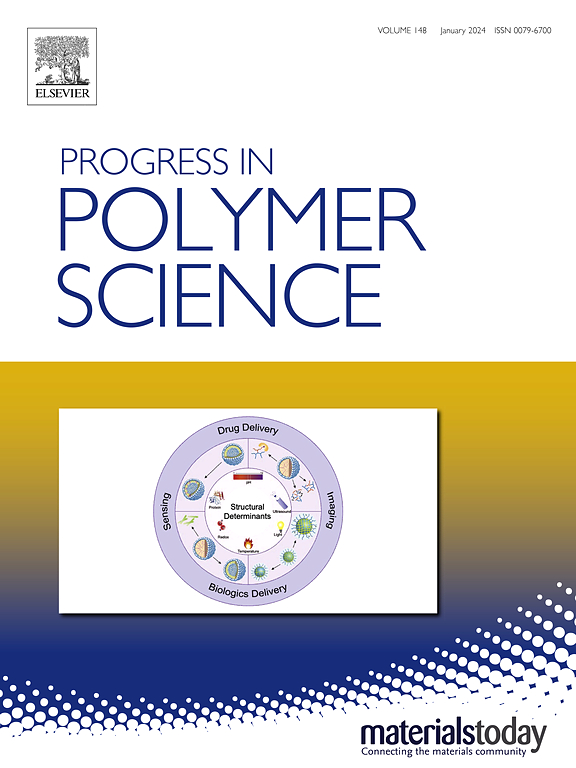Sequence-defined polymers for biomedical applications
IF 26.1
1区 化学
Q1 POLYMER SCIENCE
引用次数: 0
Abstract
Sequence-defined polymers offer unparalleled structural precision, enabling tailored biological interactions, enhanced stability, and optimized function. Unlike traditional synthetic polymers, which often lack defined structures, these materials allow for precise tuning of molecular interactions to improve biomedical performance. This review surveys advancements over the past decade, covering foundational studies that elucidate sequence-function relationships - such as interactions with model lectins - as well as direct biomedical applications including nucleotide delivery, lectin and protein inhibition, antibacterial and antiviral strategies, tumor therapy, and bioimaging. The control over polymer sequences is crucial for enhancing specificity, reducing off-target effects, and improving stability in physiological environments.
By comparing sequence-defined polymers with natural biopolymers and conventional synthetic materials, we highlight their advantages in addressing challenges like immune recognition, enzymatic degradation, and suboptimal pharmacokinetics. These materials present new avenues for developing targeted therapies, precision drug delivery systems, and advanced biomaterials.
Distinguishing itself from previous reviews focused on synthetic methodologies, this work emphasizes how sequence precision impacts biological function and thus potential biomedical applications. By summarizing foundational examples, recent breakthroughs and key challenges, we provide insights into the pivotal role of sequence-defined macromolecules in shaping the next generation of bioactive materials.

生物医学应用的序列定义聚合物
序列定义聚合物提供无与伦比的结构精度,实现定制的生物相互作用,增强的稳定性和优化的功能。不像传统的合成聚合物,通常缺乏明确的结构,这些材料允许精确调整分子相互作用,以提高生物医学性能。本文综述了过去十年的进展,包括阐明序列-功能关系的基础研究-例如与模型凝集素的相互作用-以及直接的生物医学应用,包括核苷酸传递,凝集素和蛋白质抑制,抗菌和抗病毒策略,肿瘤治疗和生物成像。控制聚合物序列对于增强特异性、减少脱靶效应和提高生理环境中的稳定性至关重要。通过将序列定义聚合物与天然生物聚合物和传统合成材料进行比较,我们强调了它们在解决免疫识别、酶降解和次优药代动力学等挑战方面的优势。这些材料为开发靶向治疗、精确给药系统和先进的生物材料提供了新的途径。与以往着重于合成方法的综述不同,这项工作强调序列精度如何影响生物功能,从而影响潜在的生物医学应用。通过总结基本的例子,最近的突破和关键挑战,我们提供了对序列定义的大分子在塑造下一代生物活性材料中的关键作用的见解。
本文章由计算机程序翻译,如有差异,请以英文原文为准。
求助全文
约1分钟内获得全文
求助全文
来源期刊

Progress in Polymer Science
化学-高分子科学
CiteScore
48.70
自引率
1.10%
发文量
54
审稿时长
38 days
期刊介绍:
Progress in Polymer Science is a journal that publishes state-of-the-art overview articles in the field of polymer science and engineering. These articles are written by internationally recognized authorities in the discipline, making it a valuable resource for staying up-to-date with the latest developments in this rapidly growing field.
The journal serves as a link between original articles, innovations published in patents, and the most current knowledge of technology. It covers a wide range of topics within the traditional fields of polymer science, including chemistry, physics, and engineering involving polymers. Additionally, it explores interdisciplinary developing fields such as functional and specialty polymers, biomaterials, polymers in drug delivery, polymers in electronic applications, composites, conducting polymers, liquid crystalline materials, and the interphases between polymers and ceramics. The journal also highlights new fabrication techniques that are making significant contributions to the field.
The subject areas covered by Progress in Polymer Science include biomaterials, materials chemistry, organic chemistry, polymers and plastics, surfaces, coatings and films, and nanotechnology. The journal is indexed and abstracted in various databases, including Materials Science Citation Index, Chemical Abstracts, Engineering Index, Current Contents, FIZ Karlsruhe, Scopus, and INSPEC.
 求助内容:
求助内容: 应助结果提醒方式:
应助结果提醒方式:


